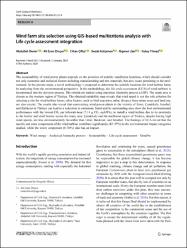| dc.contributor.author | Demir, Abdullah | |
| dc.contributor.author | Dinçer, Ali Ersin | |
| dc.contributor.author | Çiftçi, Cihan | |
| dc.contributor.author | Gülçimen, Sedat | |
| dc.contributor.author | Uzal, Nigmet | |
| dc.contributor.author | Yılmaz, Kutay | |
| dc.date.accessioned | 2024-03-04T12:44:49Z | |
| dc.date.available | 2024-03-04T12:44:49Z | |
| dc.date.issued | 2024 | en_US |
| dc.identifier.issn | 1865-0473 | |
| dc.identifier.issn | 1865-0481 | |
| dc.identifier.other | WOS:001145211100002 | |
| dc.identifier.uri | https://doi.org/10.1007/s12145-024-01227-4 | |
| dc.identifier.uri | https://hdl.handle.net/20.500.12573/1978 | |
| dc.description.abstract | The sustainability of wind power plants depends on the selection of suitable installation locations, which should consider
not only economic and technical factors including manufacturing and raw materials, but also issues pertaining to the environment. In the present study, a novel methodology is proposed to determine the suitable locations for wind turbine farms
by analyzing from the environmental perspective. In the methodology, the life cycle assessment (LCA) of wind turbines is
incorporated into the decision process. The criteria are ranked using analytical hierarchy process (AHP). The study area is
chosen as the western region of Türkiye. The obtained suitability map reveals that wind speed is not the sole criterion for
selecting a site for wind turbine farms; other factors, such as bird migration paths, distance from urban areas and land use,
are also crucial. The results also reveal that constructing wind power plants in the vicinity of İzmir, Çanakkale, Istanbul,
and Balıkesir in Türkiye can lead to a reduction in emissions. İzmir and its surrounding area show the best environmental
performance with the lowest CO2 per kilowatt-hour (7.14 g CO2 eq/kWh), to install a wind turbine due to its proximity
to the harbor and steel factory across the study area. Çanakkale and the northwest region of Türkiye, despite having high
wind speeds, are less environmentally favorable than İzmir, Balıkesir, and Istanbul. The findings of LCA reveal that the
nacelle and rotor components of the wind turbine contribute significantly (43–97%) to the environmental impact categories
studied, while the tower component (0–36%) also has an impact. | en_US |
| dc.description.sponsorship | Abdullah Gul University
Open access funding provided by the Scientific and Technological Research Council of Türkiye (TÜBİTAK). | en_US |
| dc.language.iso | eng | en_US |
| dc.publisher | SPRINGER | en_US |
| dc.relation.isversionof | 10.1007/s12145-024-01227-4 | en_US |
| dc.rights | info:eu-repo/semantics/openAccess | en_US |
| dc.subject | Wind energy | en_US |
| dc.subject | Analytical hierarchy process · | en_US |
| dc.subject | Sustainability | en_US |
| dc.subject | Life cycle assessment | en_US |
| dc.subject | SimaPro | en_US |
| dc.title | Wind farm site selection using GIS-based multicriteria analysis with Life cycle assessment integration | en_US |
| dc.type | article | en_US |
| dc.contributor.department | AGÜ, Mühendislik Fakültesi, İnşaat Mühendisliği Bölümü | en_US |
| dc.contributor.authorID | 0000-0002-6392-648X | en_US |
| dc.contributor.authorID | 0000-0002-4662-894X | en_US |
| dc.contributor.authorID | 0000-0001-9199-6437 | en_US |
| dc.contributor.authorID | 0000-0002-8967-3484 | en_US |
| dc.contributor.authorID | 0000-0002-0912-3459 | en_US |
| dc.contributor.institutionauthor | Demir, Abdullah | |
| dc.contributor.institutionauthor | Dinçer, Ali Ersin | |
| dc.contributor.institutionauthor | Çiftçi, Cihan | |
| dc.contributor.institutionauthor | Gülçimen, Sedat | |
| dc.contributor.institutionauthor | Uzal, Nigmet | |
| dc.identifier.startpage | 1 | en_US |
| dc.identifier.endpage | 18 | en_US |
| dc.relation.journal | EARTH SCIENCE INFORMATICS | en_US |
| dc.relation.publicationcategory | Makale - Uluslararası Hakemli Dergi - Kurum Öğretim Elemanı | en_US |


















